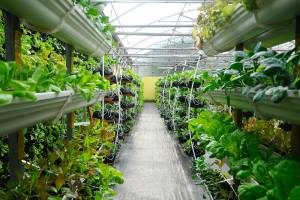Vertical farming involves growing produce indoors where farmers can control the light, temperature, amount of water given to plants and even the carbon dioxide levels. In addition to giving more control to farmers, vertical farming also allows the produce to travel fewer miles to reach the store.
There are other advantages to vertical farming in addition to helping people eat local. There is potential for the practice to greatly increase food production and expand sustainable agriculture operations, an important factor in a world where the population is increasing rapidly (between 9 and 10 billion people by 2050).

Every week, 3 million people move into a city somewhere in the world, according to the United Nations. The organization expects two-thirds of the world’s population to live in cities in the next 15 to 30 years.
In America, about 82% of all citizens live in either a medium or large city (or smaller cities on the edge of large metropolitan areas). As noted by the California Aggie, getting food to tens of millions of people living in cities is one of the problems perplexing urban planners.
Vertical farming, which allows produce to be grown indoors, could provide at least a partial solution.
Experts disagree on how much carbon dioxide is released into the atmosphere through agriculture, but some estimate as much as 25% of global emissions, according to the California Aggie. Others, such as the American Farm Bureau Federation, put that number at 9%.
Whatever the case, transportation also is a key factor in global emissions. And a large percentage of that comes from transporting food, sometimes many thousands of miles, from farms to grocery stores.
Vertical farming can cut down on food miles, a way of measuring the amount of energy used in transporting food from one location to another.
The idea of vertical farming is quickly taking hold with farmers. The U.S. Department of Agriculture has held workshops on the issue, with farmers, scientists, and engineers sharing methods for vertical farming.
Generally, vertical farming calls for raising plants on stacked shelves within an indoor facility, often old warehouses. Theoretically, they can be built anywhere. Special LED lights give the plants nutrients. Under these conditions, the plants grow faster and with less water.
While the idea is still in its early stages, many in the agriculture industry are interested in the potential, according to the BBC. As one expert said, “Basically, inside the (vertical farming) system, every day is a summer day without a cloud in the sky,”
For those interested in population and environmental issues, vertical farming is an important issue to keep an eye on.